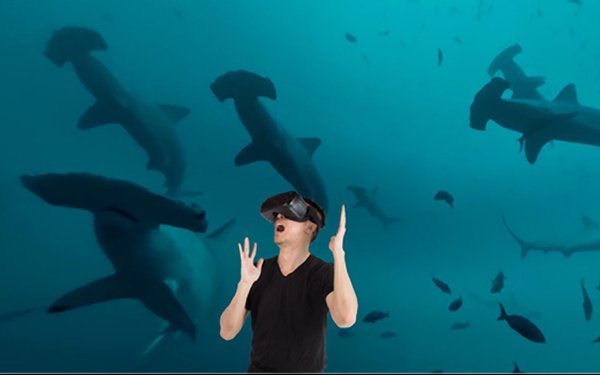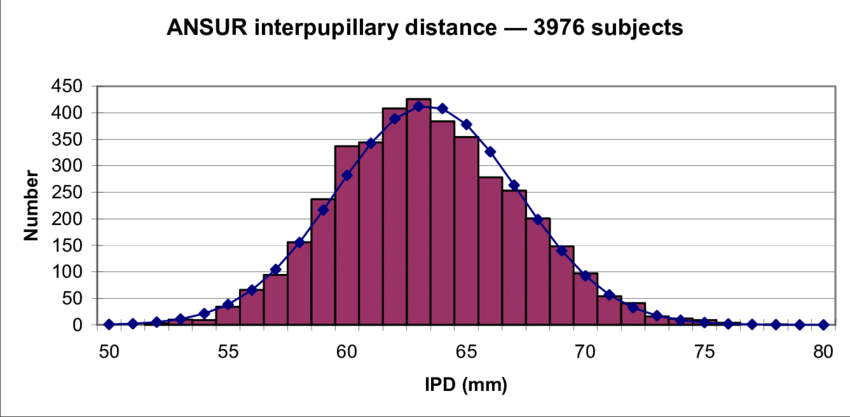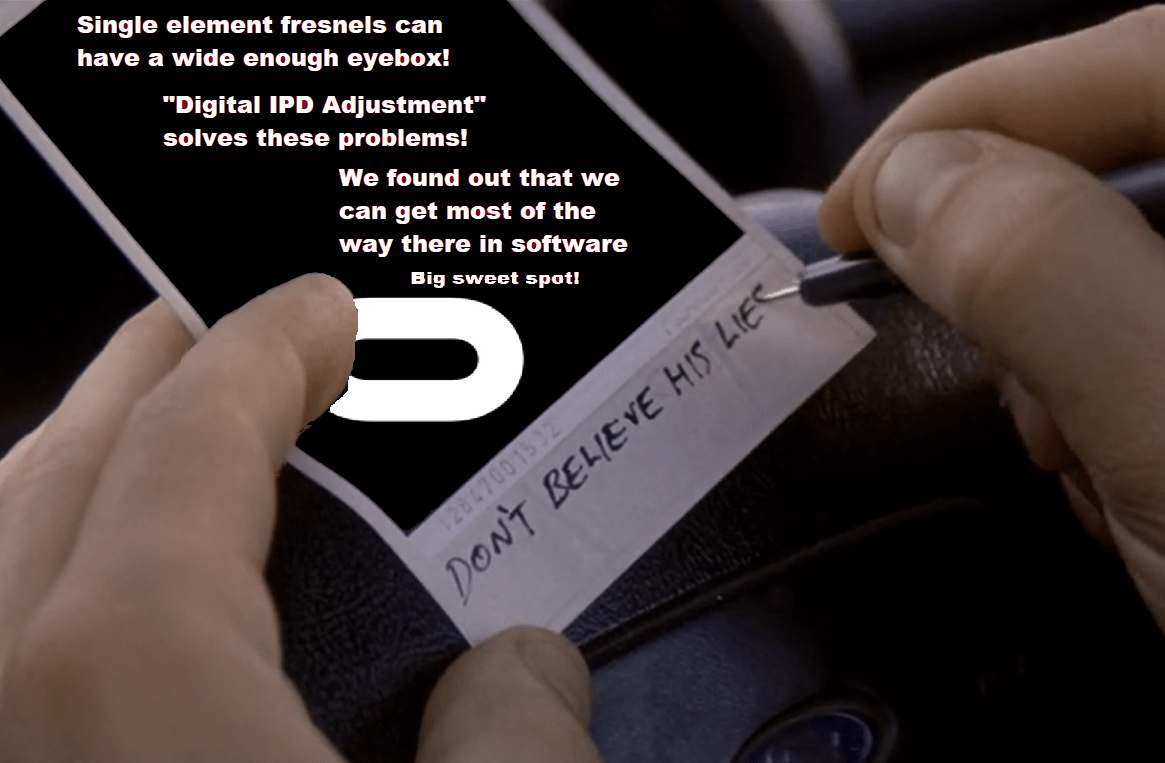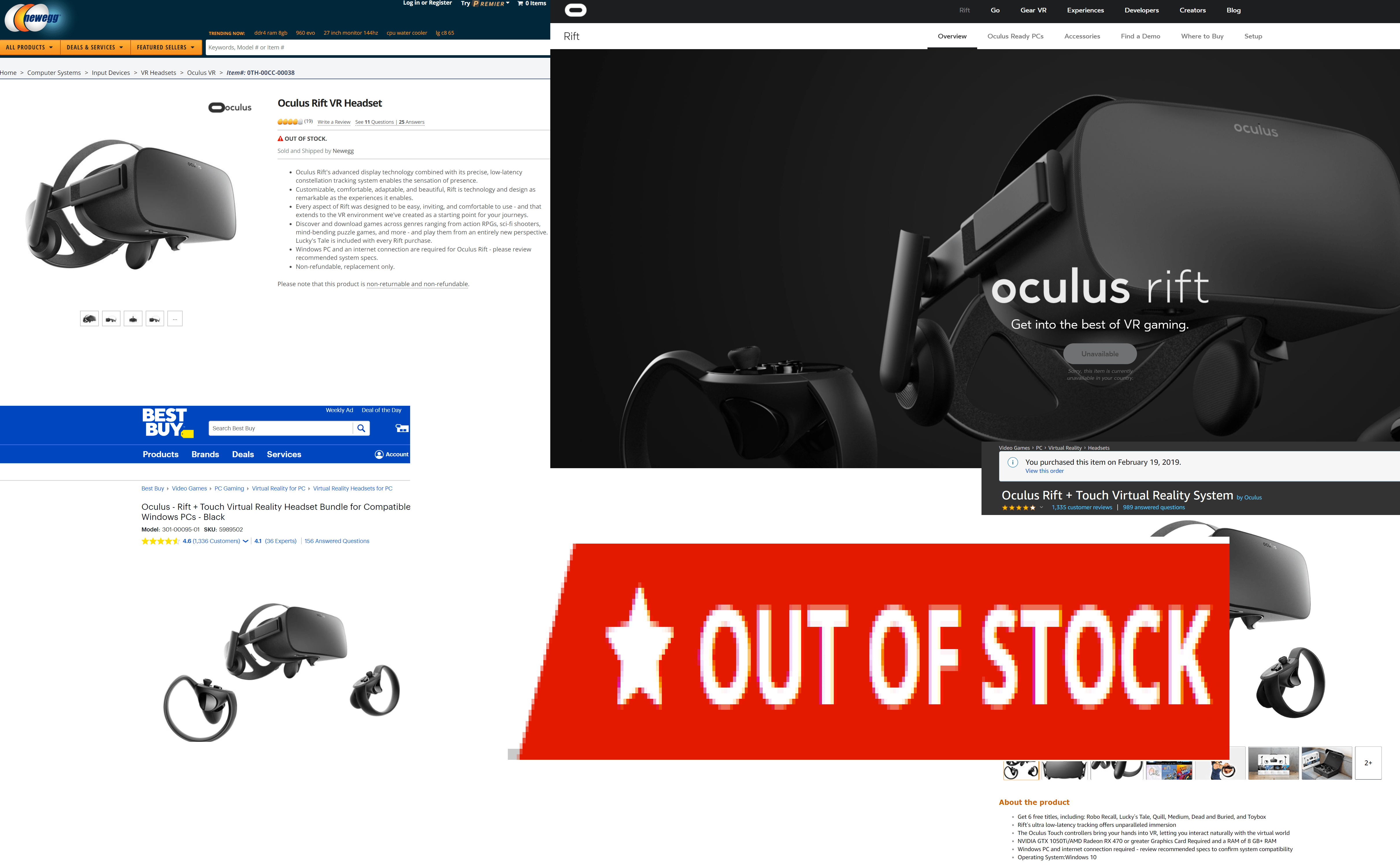I can’t use Rift S and you won’t succeed either
- Transfer

The eyes of this guy allow him to enjoy his Rift S. His friends can only envy him.
From the blog of Palmer Lucky , the inventor of the Oculus Rift virtual reality helmet, one of the founders of Oculus VR.
Rift S [ next generation of the Oculus Rift virtual reality helmet / approx. perev.] Is a very cool thing! He collects all the concepts that have existed for many years, and for the first time implements them in a functional product. Yes, yes, I see people complaining that the Rift S is worse than CV1 in audio quality, display performance and ergonomics - and some of these trade-offs are real, some are fictitious, and in general, people need to wait until it comes out, and then already draw your conclusions. In any case, it will be an excellent helmet of virtual reality (ШВР).
For about 70% of people.

Interpupillary distance distribution based on measurements in 3976 subjects
My interpupillary distance (MR) is a little less than 70 mm, and the pupils are slightly sloping to the right side of the face. One of my best friends has an MR of 59 mm. I don’t know what it is like for you, but both of us were perfectly fit with the MP tuning mechanism in Rift CV1, which was an important part of our goal to achieve compatibility with 95% of usersboth sexes. All people from the supported interval (from 58 to 72 mm) had perfect optical perception - the curvature of the field in the focal plane coincided, the geometric distortion was correctly compensated, the scale of the world was the right size, the variation in distortion with eye movements was more or less the same. The clarity of the image from one edge of the field of view to the other was normal. A small number of people with MR beyond the range did not receive perfect perception, but at least they came close to it. MR varies in different directions depending on gender, race and age, but we managed to cover almost everyone, and were proud of it.
But in the case of Rift S, this is not so. He, like Oculus Go, uses two lenses located at a distance of about 64 mm from each other, which suits the average person. Everyone who fits Cinderella’s shoe will get a perfect perception, everyone close to them will experience minor problems with visual tension, which will affect their feeling of virtual reality mainly on a subconscious level. Everyone else was out of luck, including me. The picture is difficult to put together, the details blur, the distortion compensation does not work correctly, breaking the vestibular ocular reflex, and everything is not on that scale. "Software adjustment of MR" can fix the last problem a little, but little else - it corrects one variable associated with MR, but this can not be compared with the real mechanism of MR adjustment. This is the main reason why I can not use my Oculus Go, even after serious modifications on other fronts.

- single Fresnel lenses can give a fairly wide working space!
- Digital tuning MR solves all problems!
- most of the things we can solve with the help of software!
Signature: do not believe it in a lie (remaking a frame from the " Remember " movie )
Does this mean that the Rift S needs to do a mechanical fine-tuning of the MP, like CV1?
Not. This is the simplest conclusion, but it mistakenly focuses on a specific solution to a broader problem. There are a lot of trade-offs in the development of ballasting and finding the right balance is very difficult. More important than the MR itself will be the MR tolerance, a set of factors that determine your ability to use a particular ball screw, both at rest and during movement, because of which it moves slightly on your head. MR tolerance can be approached from different angles, and here are the most common tricks.
1. Mechanical adjustment of MR
Old but good option. Most of the Balloon Systems have been approaching MR tolerance for decades in this way, mainly because of architectures that used microdisplays with a small workspace [eyebox], which required them to be perfectly positioned just to make it work at all. This approach allows the developer of ballistic control systems to concentrate on other things, such as the field of view and the curvature of the field. Linking the physical adjustment to the distance between the virtual cameras is a great way to guarantee the correct scale of the virtual world, and one ballast can be configured to be used by very different people. The option adds a little extra weight and an acceptable increase in fragility. This approach was used in Rift CV1, although we connected all the adjustments so that it slightly influenced the perception of people with asymmetric faces, such as mine.
2. Size range
My favorite option, and it will dominate the BP industry in the long run. Each adjustment of a ball screw system adds weight, volume, complexity, cost and fragility. If the helmet is suitable for the user from the very beginning, the need for adjustments can be minimized, and sometimes completely eliminated! This principle applies to all wearable goods, from shoes and clothes to watches and sunglasses - and therefore unisex overalls of universal size do not prevail in your wardrobe.
Given the small size of the BP market, it is difficult to justify the precise adjustment of each of the sold ballast. Fortunately, you can achieve a lot even with a small number of options! I'm not a big fan of Magic Leapbut they did one thing correctly - they reached the MR tolerance by making two versions of ML1, one for the wide MP and the other for the narrow. Smart Focals from North use a similar approach, but they have dozens of different sizes.
I will not pick up the words. Rift S should have done according to this scheme. Logistic costs of processing different storage units, in which slightly different plastic parts would hold the lens at slightly different distances, would allow Rift S to keep the cost low and expand the market without cutting off new and old customers.
3. Perfect collimation
Nothing is perfect, but it is possible to design optical systems with a very wide working space and little need for physical adjustment, but not without compromises. The Playstation VR is a good modern example, using solid and heavy lenses with a relatively large focal length to create a fairly wide workspace for most users. The disadvantages of this option will be the weight, cost, size and efficiency of using the panel (and, consequently, the resolution), but it will be difficult to argue with the results, especially in the case of a Balloon Switch, sold for $ 199. Rift DK2 had a fairly large workspace, which allowed it to be useful as a development tool, however, there is a reason that some users independently modifiedthis ball screw, changing the distance between the lenses. We knew that it would be irresponsible to release DK2 as a consumer product, and since the release of DK2 it took us almost two years until we decided that it could suit everyone.
4. And so it goes
One of the most common approaches to MR clearance, and one of the many reasons why BP has always failed. It’s impossible to solve engineering problems in the marketing department, but this has never stopped PR professionals. If you do nothing and claim that everything is in order, this does not help users who refuse to perceive blurry images and suffer from headaches and straining eyes. In some people, such effects appear only with the active use of ballasting, since a larger percentage of people fit into the permissible parameters if they stand still. But the same factors that allow you to increase the tolerance for MR, allow you to play more actively.
The most obvious sign of the use of such a strategy in a company is when it refuses to recognize a certain tolerance for MR, especially if in the past it proudly boasted of this parameter. If the company gives a prime number, this will allow potential consumers to make an informed decision, and everyone else to objectively calculate the number of potential consumers, and those who will not be able to use the product (or how much the acceptable quality bar has fallen). It is much easier to pretend that this is an unimportant, unsuccessful and inevitable tiny problem that does not make any demographic differences.
Why are you particularly affected by the Rift S? What about other examples of bad ballast?
Thank you for asking. Yes, there are many other helmets that do not support a large range of MPs. Many of the early Windows MR helmets were prominent members of the And So Matter Club. The SteamVR ecosystem also has a lot of outright slam helmets. I did not mention this for two reasons: firstly, I do not use them. Yes, I have almost all of the ever-made balloons and I track developments in this market, but I am tied to the Oculus platform. I buy games from the Oculus Store, launch them through the Oculus UI, and develop VR applications on the order of the military using the Oculus SDK. I am much more interested in Oculus, because I want to continue to do all of the above.
Second, and more importantly, Rift S is the only way to use the Oculus PC ecosystem. This is the only option, replacing the discontinued CV1. Anyone who cannot use Rift S is essentially cut off from the ecosystem, including people who have invested thousands of dollars in the content library. In the case of Windows MR and Steam VR, the helmets themselves are only part of a wider ecosystem, which includes helmets that support a wider range of MPs. I have no problem with the existence of low-cost balloons suitable for 70-80% of the population, as long as they have alternatives suitable for everyone else. Oculus Quest is a great thing, but it's not for PC - it's an option for people who want mobile BP but can't use Go.
Most of the time, working on Oculus, I spend on supporting helmets from other manufacturers, in particular in order to avoid such problems. So far, I don’t like the ecosystem that I helped create most of my adult life. Honestly, Oculus announced the Rift S at the GDC with a plan to meet the needs of all those who do not see themselves outside the Oculus ecosystem. If someone falls outside the range of the MP Rift S, I recommend that they stock up on the original Oculus Rift while it is still possible .

Eh ...
I love you, most Oculus users. Continue trying to release new tools for the Rift S IPD + and Rift S IPD-. I hope that in the future there will be a version for MP in 70 mm with a slight mowing to the right.
